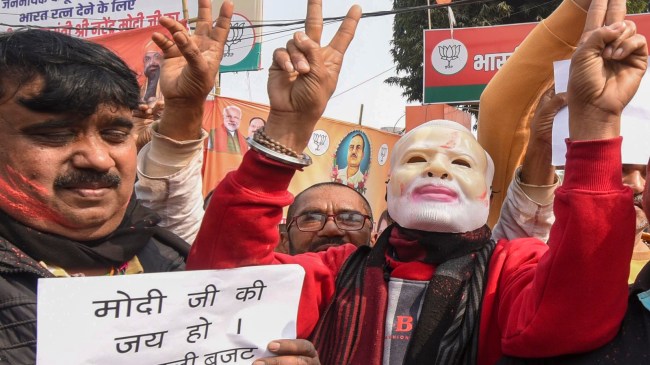Opinion Interim Budget 2024: A fine balance between expenditure and fiscal discipline
The budget has tried to focus on the quality of growth by identifying inclusive development, green growth, women and youth power as priority areas. What will be critical is how the schemes and policies identified are implemented
 BJP supporters celebrate after presentation of Interim Budget 2024 by Union Finance Minister Nirmala Sitharaman in Parliament, in Patna. (PTI)
BJP supporters celebrate after presentation of Interim Budget 2024 by Union Finance Minister Nirmala Sitharaman in Parliament, in Patna. (PTI) Given that the economy is going through a phase of steady growth, the Finance Minister has correctly focused on fiscal discipline in the interim budget. The fiscal deficit for FY25 has been budgeted much lower than market expectations. The commendable part is that this target comes with a continuing focus on capex.
The interim Union budget has been announced at a juncture when India’s economy is estimated to have recorded robust GDP growth of 7.3 per cent for FY24 (advance estimate). Thus, following a counter-cyclical fiscal policy, the FM has focused on fiscal rectitude and budgeted a fiscal deficit of 5.1 per cent of GDP for FY25. Even the fiscal deficit for FY24 is estimated to be lower at 5.8 per cent of GDP (as against budgeted 5.9 per cent). This has been achieved even with much lower nominal GDP growth of 8.7 per cent in FY24 as against budgeted growth of 10.5 per cent. The tax buoyancy for FY25 is assumed at 1.1, which looks quite achievable, given the tax buoyancy of 1.4 estimated for FY24.
The interim budget has continued the thrust on capex, which is required at this point when the private sector has been lagging on the investment front. The central government’s capex has been budgeted to grow by 11 per cent to Rs 11.1 lakh crore in FY25. The government has been focussing on capex for the last few years, given the strong multiplier effect it has on growth. The capex to GDP ratio has been maintained at a high of 3.4 per cent in FY25 (same as FY24), compared to less than 2 per cent in the years before the pandemic. Of the total capex budgeted, around 47 per cent is going into roads and railways in FY25. The continued focus on transport infrastructure should eventually help in reducing India’s logistics costs.
Moreover, in a bid to propel capex by the state governments, the outlay of Rs 1.3 lakh crore as long-term interest-free loans for capital expenditure to states has been continued.
With the fiscal deficit-reducing, the gross market borrowing has been budgeted at Rs 14.1 trillion for FY25 compared to Rs 15.4 trillion estimated for FY24. This should help in lowering government bond yields and eventually lower the overall borrowing cost for corporates, which, in turn, will be a positive for private investment.
Interestingly, even though this is a pre-election budget, the total subsidy outgo has been trimmed to Rs 4.1 trillion for FY25 from Rs 4.4 trillion estimated for FY24. This takes the subsidy-to-GDP ratio to 1.3 from 1.5 in FY24 and a peak of 3.8 in the pandemic year of FY21. The overall subsidy burden has gone down mainly due to a reduction in fertiliser subsidies, while food and petroleum subsidies have reduced marginally compared to FY24.
In the interim budget, there have been no changes in direct and indirect taxes. Given that India’s consumption revival has been weak, there were some expectations of consumption-boosting measures. However, the finance minister has stayed away from any direct consumption-boosting measures in the budget.
Another weak link to India’s growth story is the subdued demand from the rural economy. For rural development, the MGNREGS (Mahatma Gandhi National Rural Employment Guarantee Scheme) has been allocated Rs 86,000 crore (the same as the revised estimate for FY24), but higher than the budgeted amount of Rs 60,000 crore for FY24. There has been a further boost given to rural housing, with another 2 crore houses to be built in the next five years under the PM Awas Yojana (Grameen). This is a step in the right direction for rural development, given the strong multiplier effect of the housing sector.
Another commendable announcement that warrants mention is the corpus of Rs 1 lakh crore for the long-term, low or nil-interest loan, for research and innovation for the private sector. This will help India’s private sector tighten its foothold in the sunrise sectors.
Overall, the Finance Minister has done a fine balancing act by focussing on capex-led growth, even while moving towards fiscal consolidation. The budget has also tried to focus on the quality of growth by identifying inclusive development, green growth, women and youth power as priority areas. However, on this front what will be critical is how the schemes and policies identified are implemented to ensure that we truly have high quality and sustainable growth.
The writer is chief economist, CareEdge





